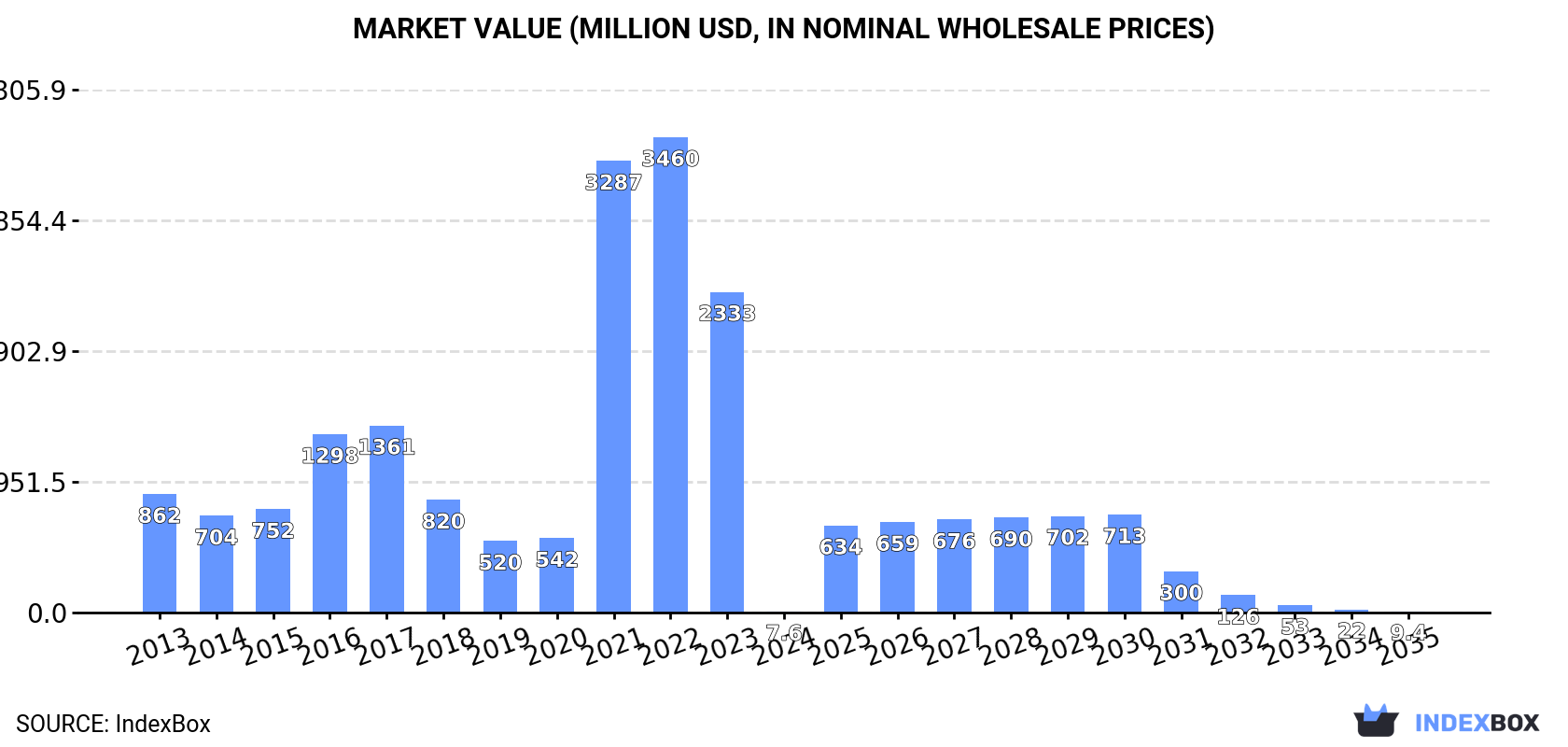May 3, 2025
IndexBox has just published a new report: Australia – Vaccines For Human Medicine – Market Analysis, Forecast, Size, Trends and Insights.
The vaccines market in Australia is poised for significant growth over the next decade, with consumption expected to rise. By 2035, the market volume is projected to reach 1.2K tons, while the market value is forecasted to reach $3.6B. This growth is attributed to the rising demand for vaccines in human medicine.
Market Forecast
Driven by increasing demand for vaccines for human medicine in Australia, the market is expected to continue an upward consumption trend over the next decade. Market performance is forecast to accelerate, expanding with an anticipated CAGR of +2.7% for the period from 2024 to 2035, which is projected to bring the market volume to 1.2K tons by the end of 2035.
In value terms, the market is forecast to increase with an anticipated CAGR of +4.3% for the period from 2024 to 2035, which is projected to bring the market value to $3.6B (in nominal wholesale prices) by the end of 2035.
 ConsumptionAustralia’s Consumption of Vaccines For Human Medicine
ConsumptionAustralia’s Consumption of Vaccines For Human Medicine
Vaccine consumption in Australia dropped dramatically to 896 tons in 2024, which is down by -50.9% on 2023 figures. In general, consumption, however, posted mild growth. As a result, consumption reached the peak volume of 2.5K tons. From 2022 to 2024, the growth of the consumption remained at a lower figure.
The value of the vaccine market in Australia contracted dramatically to $2.3B in 2024, shrinking by -32.6% against the previous year. This figure reflects the total revenues of producers and importers (excluding logistics costs, retail marketing costs, and retailers’ margins, which will be included in the final consumer price). Overall, consumption, however, recorded a moderate expansion. As a result, consumption attained the peak level of $4.6B. From 2022 to 2024, the growth of the market remained at a somewhat lower figure.
ProductionAustralia’s Production of Vaccines For Human Medicine
In 2024, production of vaccines for human medicine in Australia stood at 906 tons, remaining relatively unchanged against the year before. In general, production saw significant growth. The pace of growth was the most pronounced in 2020 with an increase of 44%. Vaccine production peaked in 2024 and is expected to retain growth in the near future.
In value terms, vaccine production amounted to $664M in 2024 estimated in export price. Overall, production saw a significant increase. The pace of growth was the most pronounced in 2020 when the production volume increased by 41%. Vaccine production peaked in 2024 and is likely to continue growth in the immediate term.
ImportsAustralia’s Imports of Vaccines For Human Medicine
In 2024, overseas purchases of vaccines for human medicine decreased by -98.3% to 33 tons, falling for the second year in a row after two years of growth. In general, imports saw a sharp descent. The most prominent rate of growth was recorded in 2021 with an increase of 484%. Imports peaked at 2.9K tons in 2022; however, from 2023 to 2024, imports stood at a somewhat lower figure.
In value terms, vaccine imports dropped rapidly to $834M in 2024. Over the period under review, imports, however, recorded strong growth. The pace of growth appeared the most rapid in 2021 when imports increased by 487% against the previous year. Imports peaked at $1.9B in 2022; however, from 2023 to 2024, imports failed to regain momentum.
Imports By Country
In 2024, Belgium (21 tons) constituted the largest supplier of vaccine to Australia, accounting for a 65% share of total imports. Moreover, vaccine imports from Belgium exceeded the figures recorded by the second-largest supplier, the United States (3 tons), sevenfold. The third position in this ranking was held by Italy (2.6 tons), with a 7.8% share.
From 2013 to 2024, the average annual rate of growth in terms of volume from Belgium amounted to -22.7%. The remaining supplying countries recorded the following average annual rates of imports growth: the United States (-32.2% per year) and Italy (-10.7% per year).
In value terms, Belgium ($498M) constituted the largest supplier of vaccines for human medicine to Australia, comprising 60% of total imports. The second position in the ranking was taken by Italy ($68M), with an 8.1% share of total imports. It was followed by the United States, with a 7% share.
From 2013 to 2024, the average annual growth rate of value from Belgium stood at +11.1%. The remaining supplying countries recorded the following average annual rates of imports growth: Italy (+42.8% per year) and the United States (-9.6% per year).
Import Prices By Country
The average vaccine import price stood at $25,334,362 per ton in 2024, picking up by 3,647% against the previous year. In general, the import price continues to indicate a significant increase. As a result, import price attained the peak level and is likely to continue growth in the immediate term.
Prices varied noticeably by country of origin: amid the top importers, the country with the highest price was the UK ($42,569,984 per ton), while the price for South Korea ($5,568,000 per ton) was amongst the lowest.
From 2013 to 2024, the most notable rate of growth in terms of prices was attained by Italy (+60.0%), while the prices for the other major suppliers experienced more modest paces of growth.
ExportsAustralia’s Exports of Vaccines For Human Medicine
In 2024, overseas shipments of vaccines for human medicine decreased by -37.6% to 43 tons, falling for the second year in a row after three years of growth. Over the period under review, exports continue to indicate a abrupt curtailment. The pace of growth was the most pronounced in 2022 when exports increased by 1,119%. As a result, the exports reached the peak of 2K tons. From 2023 to 2024, the growth of the exports failed to regain momentum.
In value terms, vaccine exports dropped remarkably to $54M in 2024. Overall, exports continue to indicate a abrupt setback. The pace of growth appeared the most rapid in 2021 when exports increased by 56% against the previous year. The exports peaked at $153M in 2013; however, from 2014 to 2024, the exports stood at a somewhat lower figure.
Exports By Country
New Zealand (13 tons), the United States (12 tons) and Germany (5.5 tons) were the main destinations of vaccine exports from Australia, together comprising 72% of total exports. Thailand, Fiji, Argentina and Singapore lagged somewhat behind, together comprising a further 21%.
From 2013 to 2024, the most notable rate of growth in terms of shipments, amongst the main countries of destination, was attained by Fiji (with a CAGR of +36.1%), while the other leaders experienced mixed trend patterns.
In value terms, the United States ($29M), Germany ($19M) and New Zealand ($3.5M) constituted the largest markets for vaccine exported from Australia worldwide, together comprising 96% of total exports. Thailand, Fiji, Argentina and Singapore lagged somewhat behind, together comprising a further 3%.
Fiji, with a CAGR of +28.4%, saw the highest rates of growth with regard to the value of exports, in terms of the main countries of destination over the period under review, while shipments for the other leaders experienced mixed trend patterns.
Export Prices By Country
The average vaccine export price stood at $1,271,069 per ton in 2024, jumping by 25% against the previous year. Overall, the export price recorded a buoyant expansion. The growth pace was the most rapid in 2023 an increase of 1,346% against the previous year. Over the period under review, the average export prices reached the peak figure at $1,638,528 per ton in 2019; however, from 2020 to 2024, the export prices stood at a somewhat lower figure.
Prices varied noticeably by country of destination: amid the top suppliers, the country with the highest price was Germany ($3,493,386 per ton), while the average price for exports to Fiji ($88,472 per ton) was amongst the lowest.
From 2013 to 2024, the most notable rate of growth in terms of prices was recorded for supplies to China (+31.7%), while the prices for the other major destinations experienced more modest paces of growth.
